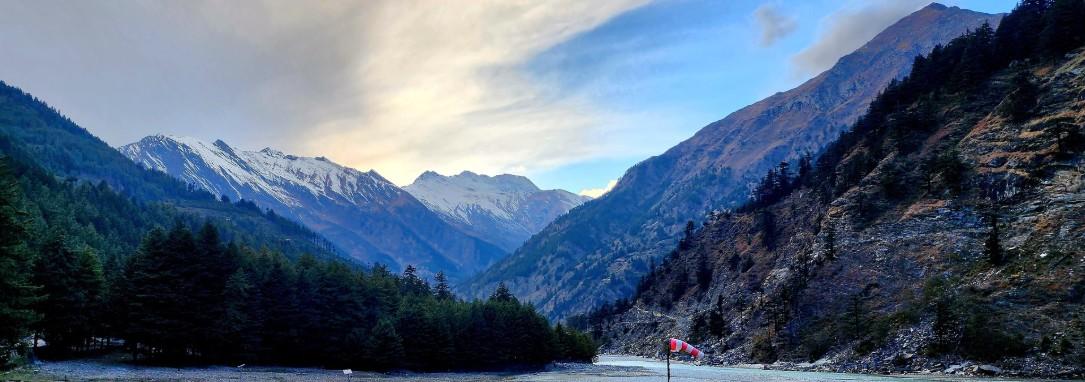Notifications
Ankit Rawat Invalid date 6 minutes, 59 seconds
408 views 0 Comments 0 Likes 0 Reviews

If you are yearning for an offbeat mountain escape far from the chaos of city life, Harsil Valley is the perfect destination. Nestled in the lap of the Garhwal Himalayas in Uttarakhand, Harsil is a serene and relatively unexplored valley, offering breathtaking views, apple orchards, pine forests, and gurgling rivers. This guide covers everything you need to know about planning a trip from Delhi to Harsil Valley, including the best routes, attractions, and nearby places to visit.
Harsil Valley from Delhi is approximately 500 kilometers away and can be reached by road, rail, or air combined with road travel.
Traveling by road is the most scenic and flexible option. The journey takes around 12 to 14 hours depending on traffic and road conditions. The most common route is:
Delhi – Rishikesh – Uttarkashi – Harsil
The roads are well-maintained up to Uttarkashi, and the route from Uttarkashi to Harsil offers mesmerizing views of the Bhagirathi River and dense forests.
The nearest railway station is Rishikesh or Dehradun, both well-connected to Delhi. From there, you can hire a taxi or take a local bus to reach Harsil.
The closest airport is Jolly Grant Airport in Dehradun, about 240 kilometers from Harsil. After landing, a road journey via Rishikesh and Uttarkashi will take you to the valley.
If you crave calm and crisp mountain air, Harsil Valley is your perfect escape.
Harsil is an unspoiled paradise in the Himalayas, perfect for those who want to avoid the commercialized hill stations. Set at an altitude of 2620 meters, the valley is renowned for:
Tranquil environment
Picturesque landscapes
Apple orchards
Dense deodar forests
Proximity to the holy town of Gangotri
Harsil also lies on the ancient route to Tibet and holds great cultural and historical significance.
The best time to plan a trip from Delhi to Harsil Valley is between April to June and September to November.
Summer (April to June): Pleasant weather with temperatures ranging between 10°C to 20°C.
Autumn (September to November): Post-monsoon freshness with clear skies and vibrant landscapes.
Winter (December to March): Snow-covered scenery, ideal for snow lovers, though the region may be difficult to access due to heavy snowfall.
While Harsil itself is a peaceful retreat, several stunning attractions lie within close proximity:
Located just 25 kilometers from Harsil, Gangotri is one of the four sacred Char Dham pilgrimage sites. It is the origin of the holy river Ganga, and visiting the Gangotri Temple is a spiritually uplifting experience.
Just 3 kilometers from Harsil, Dharali is a quaint village with apple orchards and traditional wooden houses. It's a great place to take long walks, interact with locals, and soak in the Himalayan beauty.
Mukhwa serves as the winter home for the idol of Goddess Ganga. It's a quiet village located near Harsil and offers a glimpse into Garhwali culture.
Not to be confused with the lake in Nainital, this Sat Tal near Harsil is a cluster of seven lakes surrounded by lush forests. It's a great destination for nature lovers and trekkers.
The pristine Bhagirathi River flows through Harsil, making it an excellent spot for riverside picnics, photography, and peaceful reflection.
Located about 26 kilometers from Harsil, Gangnani is known for its natural hot water springs. It’s a refreshing stopover on the way to or from Gangotri.
Harsil is perfect for slow travel and immersive experiences:
Trekking: Several trails lead out from Harsil, including hikes to Gartang Gali and Lama Top.
Photography: The pristine beauty and dramatic Himalayan landscapes are a dream for photographers.
Village Walks: Interact with the locals and explore apple orchards and traditional architecture.
Meditation and Yoga: The serene atmosphere makes Harsil a perfect place to rejuvenate mentally and spiritually.
Start early if you're driving from Delhi to avoid traffic and make the most of daylight.
Carry warm clothes, even in summer, as temperatures can drop significantly at night.
Avoid monsoon months (July to early September) due to the risk of landslides.
Fuel up in Uttarkashi, as fuel stations are scarce beyond that.
Stay connected, though mobile network coverage may be limited in some areas.
Respect local customs and nature, especially if visiting temples or sacred sites.
Harsil Valley is one of Uttarakhand’s best-kept secrets and an ideal destination for travelers seeking tranquility, natural beauty, and spiritual connection. A journey from Delhi to Harsil Valley is not just a change in scenery, but a soulful escape into the heart of the Himalayas.
Whether you're looking for a peaceful retreat, a spiritual journey to Gangotri, or a raw Himalayan adventure, Harsil offers it all without the crowds. Pack your bags, charge your camera, and get ready to discover this hidden gem on your next mountain escape.

